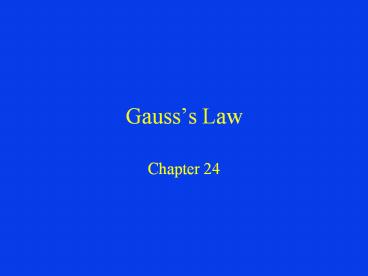Gauss PowerPoint PPT Presentation
Title: Gauss
1
Gausss Law
- Chapter 24
2
Electric Flux
We define the electric flux ?, of the electric
field E, through the surface A, as
F E . A
E
A
area A
Where A is a vector normal to the surface
(magnitude A, and direction normal to the
surface outwards in a closed surface)
3
Electric Flux
You can think of the flux through some surface as
a measure of the number of field lines which pass
through that surface.
Flux depends on the strength of E, on the surface
area, and on the relative orientation of the
field and surface.
E
A
Normal to surface, magnitude A
A ?
Here the flux is F E A
4
Electric Flux
The flux also depends on orientation
F E . A E A cos q
area A
area A
E
E
q
q
A
A
A cos q
A cos q
5
What if the surface is curved, or the field
varies with position ??
? E . A
1. We divide the surface into small regions
with area dA
2. The flux through dA is dF E dA cos q
dF E . dA
A
3. To obtain the total flux we need to
integrate over the surface A
6
In the case of a closed surface
The loop means the integral is over a closed
surface.
dA
q
E
7
Gausss Law
The electric flux through any closed surface
equals ? enclosed charge / ?0
This is always true. Occasionally, it provides a
very easy way to find the electric field (for
highly symmetric cases).
8
Calculate the electric field produced by a point
charge using Gauss Law
We choose for the gaussian surface a sphere of
radius r, centered on the charge Q. Then, the
electric field E, has the same magnitude
everywhere on the surface (radial symmetry)
Furthermore, at each point on the surface, the
field E and the surface normal dA are parallel
(both point radially outward). E . dA E dA
cos ? 1
9
? E . dA Q / e0
Electric field produced by a point charge
? E . dA E ? dA E A
E
A 4 ? r2
E A E 4 ? r2 Q / e0
E
Q
Q
Coulombs Law !
10
Is Gausss Law more fundamental than Coulombs
Law?
- No! Here we derived Coulombs law for a point
charge from Gausss law. - One can instead derive Gausss law for a general
(even very nasty) charge distribution from
Coulombs law. The two laws are equivalent. - Gausss law gives us an easy way to solve a few
very symmetric problems in electrostatics. - It also gives us great insight into the electric
fields in and on conductors and within voids
inside metals.
11
12
Applying Gausss law in spherical geometry
E
13
(No Transcript)

